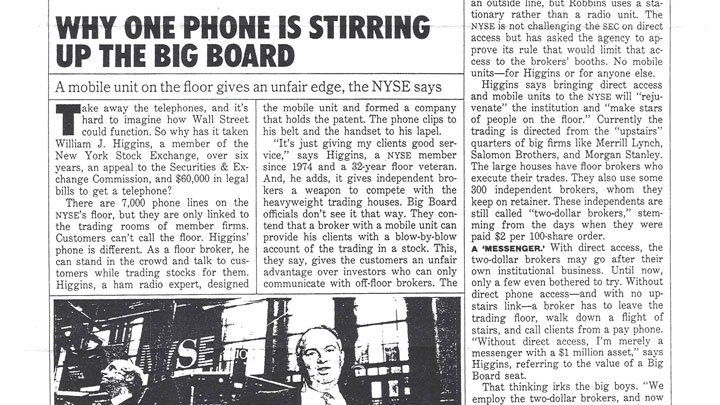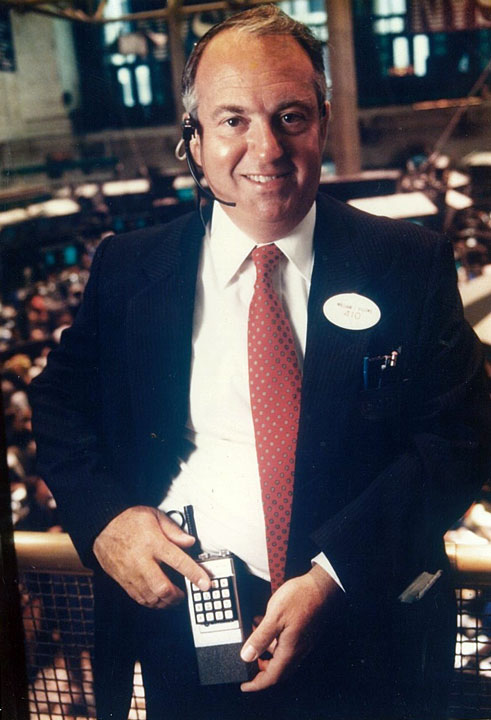Take away the telephones, and it's hard to imagine how Wall Street could function. So why has it taken William J. Higgins, a member of the New York Stock Exchange, over six years, an appeal to the Securities & Exchange Commission, and $60,000 in legal bills to get a telephone?
There are 7,000 phone lines on the NYSE's floor, but they are only linked to the trading rooms of member firms. Customers can't call the floor. Higgins' phone is different. As a floor broker, he can stand in the crowd and talk to customers while trading stocks for them. Higgins, a ham radio expert, designed the mobile unit and formed a company that holds the patent. The phone clips to his belt and the handset to his lapel.
"It's just giving my clients good service," says Higgins, a NYSE member since 1974 and a 32-year floor veteran. And, he adds, it gives independent brokers a weapon to compete with the heavyweight trading houses. Big Board officials don't see it that way. They contend that a broker with a mobile unit can provide his clients with a blow-by-blow account of the trading in a stock. This, they say, gives the customers an unfair advantage over investors who can only communicate with off-floor brokers. The exchange has now asked the SEC to take away Higgins' mobile unit.
Higgins successfully challenged the Big Board's long-standing policy forbidding nonmembers of the exchange, such as the brokers' clients, from having direet telephone access to the floor. Higgins started his fight for phones in early 1981, grinding his way through the NYSE's committee system. At that time, he had the backing of the Alliance of Floor Brokers.
Rebuffed by the Big Board, Higgins appealed to the SEC in 1986, but he had lost the financial backing of the floor brokers' alliance. The regulators finally ruled Higgins could have a phone because the Big Board had no specific rule barring it. A second floor broker, Michael D. Robbins, also asked the SEC for an outside line, but Robbins uses a stationary rather than a radio unit. The NYSE is· not challenging the SEC on direct access but has asked the agency to approve its rule that would limit that access to the brokers' booths. No mobile units-for Higgins or for anyone else.
Higgins says bringing direct access and mobile units to the NYSE will "rejuvenate" the institution and "make stars of people on the floor." Currently the trading is directed from the "upstairs" quarters of big firms like Merrill Lynch, Salomon Brothers, and Morgan Stanley. The large houses have floor brokers who execute their trades. They also use some 300 independent brokers, whom they keep on retainer. These independents are still called "two-dollar brokers," stemming from the days when they were paid $2 per 100-share order.
A 'MESSENGER.' With direct access, the two-dollar brokers may go after their own institutional business. Until now, only a few even bothered to try. Without direct phone access-and with no upstairs link-a broker has to leave the trading floor, walk down a flight of stairs, and call clients from a pay phone. "Without direct access, I'm merely a messenger with a $1 million asset," says Higgins, referring to the value of a Big Board seat.
That thinking irks the big boys. "We employ the two-dollar brokers, and now they want to compete with us," fumes one trading chief. "We invest big money to bring business to the exchange. What do these guys contribute?"
What they contribute is beside the point. So far, about 100 floor brokers have applied-and 60 already have--direet- access phone lines at their booths. And if the SEC allows Higgins to keep his mobile phone over the Big Board's objections, some of the more aggressive independents will likely follow Higgins' lead. The result? Increased competition and maybe even lower commission rates.
By Jeffrey M. Laderman in New York

